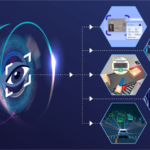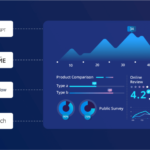
Introduction
RPA also known as Robotic Automation has already started changing business organizations in a very large way. They assist in minimizing repetition hence eliminating possibilities of errors arising from it. The responsibility for handling processes within a specific amount of time with high efficiency lies on the virtual assistant bots.
Benefits such as cost advantage and productivity improvement are seen to be gotten by firms. This technology is reshaping industries.
As business world and the competition intensifies, it is very important for every organization to understand the significance of RPA. To begin this article, the author explains the principle of operation of RPA and the benefits that it has.
What is Robotic Process Automation (RPA)?
RPA is a software that automates the functions that were normally performed by human beings. It automated man activities in the digital systems. These can input data, conduct transactions and interact with other systems such as agents.
That has given RPA a different characteristic from other modes of automation because it uses limited transformations in the systems. There is also the ability to interface with other software, and this makes this software very easy to employ in any organization.
How RPA Works
RPA rely on the gaining of knowledge and utilization of artificial intelligence and machine learning algorithms. Bots are so structured to perform tasks that involve human-like automated execution of certain tasks.
As well they are able to pull information, check data and produce reports as well. Some of RPA solutions include the following: cognitive automation to enable the solutions to make decisions. They incorporate artificial intelligence into the process of business automation making it fast and time-saving.
Benefits of RPA
From this kind of employment, various benefits emerge to the organizations implementing RPA. It increases accuracy since errors that may be produced by human beings in performing a task are minimized. Bots work 24/7, increasing productivity.
Thus, RPA saves costs in line with the number of activities and processes that requires human resource involvement frequently. As for the benefit, it enhances a corporation’s compliance to observe some strict norms.
The other advantage that businesses derive from the use of bots is the ability to expand their capacity to undertake more work. Thus, RPA brings significant advantages and becomes an attractive opportunity for the successful implementation for both large and small business.
Industries Using RPA
Various industries leverage RPA to streamline workflows. In finance, automated chats and calls operate in transactions and in filing of regulatory reports. RPA has its application in healthcare organizations where it is used to manage patients’ details.
Manufacturing companies automate inventory tracking. Chains of stores rely on RPA to improve both their supply chains and the service provided to customers. Each organization boasts of the best automated systems, cutting on cost and increasing efficiency in the overall operations.
RPA and Artificial Intelligence
RPA is made smarter by integrating AI in the development of solutions, therefore forming a strength in RPA. RPA driven by AI can manage the levels of data that contain no structure, while learning its actions. For building bots, it is possible to add a machine learning component to the bots, and thus have them become better when used with time.
They use Natural language processing to interpret communication that comes from fellow human beings. Integrating with RPA yields Intelligent Automation which brings a drastic change in the business processes.
Implementing RPA in Business
It is clearly important to understand that the implementation process of RPA is not very easy at all and it needs adequate planning. There are several tasks that may be accomplished depending on the type of business being conducted to suitably automate all the business processes. Choosing the right tool is quite essential especially when it comes to RPA.
Employee training ensures smooth adoption. In this thesis, the monitoring of the bot’s performance can serve the purpose of improving processes.
Lack of a specific structure means the business does not fully harness RPA to its potential. Contrary to incomplete or improper implementation, leads to long-term success.
Challenges of RPA Adoption
However, it is crucial to note that there are drawbacks of using RPA. One of the limitations is that it entails high-cost input at the initial stage, thus requiring many resources, time and money for the company to recover from such loss. Some of these employees resist automation because of their job.
Possible issues may include integration with legacy systems. It noted that some of the checks require constant monitoring in order to keep effectiveness in check.
These are some of the challenges that need to be overcome in order to achieve successful automation in commerce companies. These challenges are well addressed when strategic planning is applied.
RPA Security Considerations
Security is a contentious factor especially when it comes to the implementation of RPA in organizations. It involves handling of sensitive information hence have to include enhanced security measures. Hence businesses must ensure that it provides access controls and uses encryption.
It should be noted that compliance with regulations concerning data protection should be conducted on a regular basis. Cybersecurity protocols prevent unauthorized access. Security is quite critical to RPA to ensure integrity and trust in the business data used in automating specific processes.
The Future of RPA
Advanced authorities point towards a very bright future for RPA. As it stands, AI will enhance the bot’s abilities to the point where they will be smarter. It was thus found that the integration of hyperautomation with the other technologies will improve the efficacy of RPA.
Automation will remain increasingly adopted in more organizations as more of them seek ways of achieving competitive advantage. RPA will surely progress hence leading to changes in the coming future in most industries. The technology has to be adopted by organizations to enable them operate in the future.
RPA Success Stories
As it has been identified, a large number of companies can successfully implement RPA. There is an automation of loan processes in banks among which the time to approve such loans is reduced. Healthcare providers redesign patient booking using bots.
Internet firms contribute to increasing the effectiveness of order processing. The above-mentioned are examples proving that RPA is feasible. The use of RPA gives business competitive advantage since customers satisfaction and chance of completion are enhanced.
Conclusion
What you should know is that RPA has many benefits for businesses When you hear the term Robotic Process Automation (RPA), It helps in performing the recurring activities in a faster and efficient manner. Artificial intelligence helps to minimize expenditures and increased effectiveness and efficiency of various business processes.
As the above examples have shown, despite the challenges, when a change initiative is strategic in its implementation, it will definitely succeed.
There is little doubt that further development of RPA will extend to the industries as well. It will be seen that the concept of automation plays an important step in the business to cope with the increasing competition.







